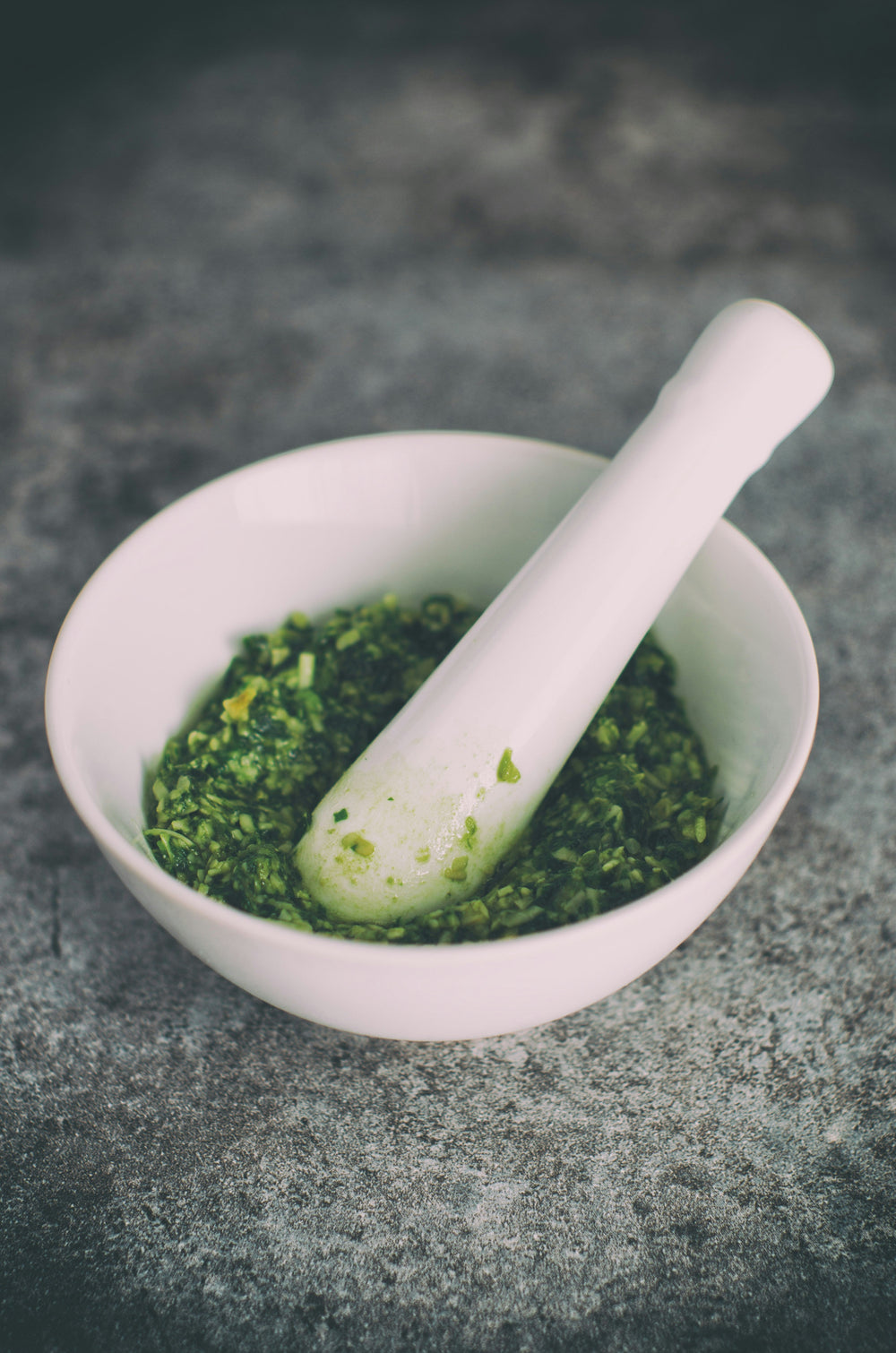This creamy green soup brings together broccoli, cauliflower, and kale for a delicious bowl that feels both comforting and energising. Finished with crispy chickpeas and toasted almonds, it is an easy way to enjoy a whole day’s worth of greens in one simple, nourishing meal.
how to protect your gut from traveller's diarrhoea.
Travelling opens up exciting new experiences, but it can also introduce a few unwelcome surprises such as travellers’ diarrhoea — a short-term digestive upset that affects many people when visiting certain parts of the world. This condition is defined as having three or more loose or watery bowel movements within 24 hours. It is most commonly seen in people travelling to regions such as Africa, Asia, Central and South America, and the Middle East, where food and water hygiene may differ from what we are used to. It usually lasts three to five days but it can be uncomfortable and disruptive. Understanding how it affects your gut health can help you protect your wellbeing while still enjoying your journey. Recognising the Symptoms The symptoms of travellers’ diarrhoea can vary, but they often include the following: Abdominal cramps or bloating (often mistaken for general travel bloat) Loose or watery stools Increased urgency to use the toilet Nausea or vomiting Fatigue or feeling weak Fever While many cases resolve on their own, it is important to stay alert to how your body is responding, especially if symptoms persist. Seek medical help if symptoms worsen. What Causes It Travellers’ diarrhoea is most often caused by eating or drinking something that has been contaminated with bacteria, viruses, or parasites. Around 90 percent of cases are caused by bacteria, with Escherichia coli being the most common. Other bacteria such as Salmonella, Shigella, Campylobacter and Vibrio can also be involved. These harmful microorganisms can disrupt the delicate balance of bacteria in your gut microbiome. This community of microbes plays a key role in digestion, nutrient absorption, and immune defence. When this balance is disturbed, your gut may struggle to function properly, leading to diarrhoea and other symptoms. Looking After Your Gut While Abroad Although travellers’ diarrhoea...

Travelling opens up exciting new experiences, but it can also introduce a few unwelcome surprises such as travellers’ diarrhoea — a short-term digestive upset that affects many people when visiting certain parts of the world.
This condition is defined as having three or more loose or watery bowel movements within 24 hours. It is most commonly seen in people travelling to regions such as Africa, Asia, Central and South America, and the Middle East, where food and water hygiene may differ from what we are used to.
It usually lasts three to five days but it can be uncomfortable and disruptive. Understanding how it affects your gut health can help you protect your wellbeing while still enjoying your journey.
Recognising the Symptoms
The symptoms of travellers’ diarrhoea can vary, but they often include the following:
-
Abdominal cramps or bloating (often mistaken for general travel bloat)
-
Loose or watery stools
-
Increased urgency to use the toilet
-
Nausea or vomiting
-
Fatigue or feeling weak
-
Fever
While many cases resolve on their own, it is important to stay alert to how your body is responding, especially if symptoms persist. Seek medical help if symptoms worsen.
What Causes It
Travellers’ diarrhoea is most often caused by eating or drinking something that has been contaminated with bacteria, viruses, or parasites.
Around 90 percent of cases are caused by bacteria, with Escherichia coli being the most common. Other bacteria such as Salmonella, Shigella, Campylobacter and Vibrio can also be involved.
These harmful microorganisms can disrupt the delicate balance of bacteria in your gut microbiome. This community of microbes plays a key role in digestion, nutrient absorption, and immune defence. When this balance is disturbed, your gut may struggle to function properly, leading to diarrhoea and other symptoms.
Looking After Your Gut While Abroad
Although travellers’ diarrhoea is difficult to avoid entirely, there are steps you can take to reduce your risk and support your digestive and gut health while travelling.
Choose food and water carefully
Stick to hot meals that are cooked all the way through. Avoid raw fruit and vegetables unless you can peel them. Avoid salads, as they are often rinsed in local tap water.
Drink only bottled water that is properly sealed, or water that has been boiled and cooled. Use this water to brush your teeth as well. Avoid drinks with ice, as the water used to make it may be unfiltered.
Keep your hands clean
Regular hand washing is one of the most effective ways to avoid illness while travelling. Wash your hands with soap and warm water before eating, after using the toilet, and after visiting markets or handling animals. Always carry a small bottle of hand sanitiser in case soap and water are not available.
Hygiene is extremely important. In areas with lower sanitation and higher temperatures throughout the year, the rates of travellers’ diarrhoea can be as high as 50 to 60 percent.
Support your microbiome with probiotics
Probiotics are beneficial bacteria that can help maintain the balance of your gut microbiome. Certain strains, including Lactobacillus acidophilus and Lactobacillus rhamnosus, have been studied for their potential to prevent travellers’ diarrhoea.
By supporting the gut’s natural defences, probiotics may reduce the chances of harmful bacteria taking hold. Consider starting a probiotic supplement a few weeks before travel and continuing while you are away.
Stay hydrated and well rested
If you do become unwell, make hydration your priority. Water and oral rehydration salts can help replace lost fluids and essential minerals.
Try to rest as much as possible and avoid alcohol, which can further irritate your digestive system.
Conclusion
Travellers’ diarrhoea is common, but it does not have to define your travel experience. By taking care of your gut health and being mindful of food and water choices, you can feel more confident, resilient, and comfortable while you are away.
References
Alharbi, B. F., & Alateek, A. A. (2024). Investigating the influence of probiotics in preventing traveler’s diarrhea: Meta-analysis based systematic review. Travel Medicine and Infectious Disease, 58, 102703. https://doi.org/10.1016/j.tmaid.2024.102703
Steffen, R., Hill, D. R., & DuPont, H. L. (2015). Traveler’s diarrhea: A clinical review. JAMA, 313(1), 71–80. https://doi.org/10.1001/jama.2014.17006
lifestyle. gut health recipes.
ready in 10 minutes
herb-whipped cottage cheese chicken bagels.
These basil whipped cottage cheese protein bagels make a fresh, high-protein breakfast or lunch, combining creamy herb-blended cottage cheese with juicy chicken, rocket, and tomatoes. They’re quick to assemble, packed with flavour, and perfect for a nourishing breakfast or light lunch.
ready in 10 minutes
kiwi chocolate protein chia pots.
These Kiwi Chocolate Protein Chia Pots make an ideal high-fibre, high-protein breakfast that keeps you full and energised all morning. They’re quick to prepare, easy to store, and perfect for a healthy grab-and-go option.
ready in 15 minutes
spiced apple porridge.
This spiced apple and pumpkin seed porridge is a warming, high-fibre breakfast that’s perfect for cosy mornings. Made with creamy oats, gently caramelised apples and a crunchy pumpkin seed topping, it’s ready in just 15 minutes and serves one.
ready in 50 minutes
prep-ahead baked blueberry oats.
These prep-ahead oven-baked oats with blueberries and bananas are rich in protein and fibre, making them a nourishing, gut-friendly breakfast to enjoy all week.
ready in 15 minutes
spicy green eggs with feta.
These spicy green eggs with feta are a quick, protein-rich recipe packed with gut-friendly ingredients like spinach, courgette, and spring onion. Baked in the oven or air fryer, they’re simple to make, full of flavour, and support digestion with a balance of fibre, protein, and healthy fats. Perfect for breakfast, brunch, or a light meal, this vibrant dish proves that nourishing your gut can be both delicious and easy.
ready in 10 minutes
egg wrap with pesto.
Bright, fresh, and ready in just 10 minutes, this flavour-packed wrap serves one and is ideal for breakfast, lunch, or any time you’re after something simple yet filling.
ready in 10 minutes
peach cobbler overnight oats.
Start your day with a gut-friendly twist on a classic dessert. The peach cobbler overnight oats serve 2–3 and takes just 10 minutes to prepare the night before. Packed with fibre, flavour and feel-good ingredients, it’s the perfect make-ahead option for busy mornings or a nourishing snack you can enjoy any time of day.
ready in 15 minutes
smoky egg salad bagel crunch.
This smoky harissa egg bagel is the perfect 15-minute meal. Made with creamy Greek yoghurt, tangy pickles, and a hint of spice, it’s a high-protein twist on classic egg salad that delivers on both taste and texture. Ideal for busy days, this easy bagel recipe makes lunch feel gourmet without the effort.
ready in 20 minutes
chewy breakfast matcha protein cookies.
Soft, satisfying, and subtly sweet—these breakfast cookies are made to fuel your morning the right way. With fibre-rich oats, plant-based protein, and antioxidant-packed matcha, they’re a gut-friendly grab-and-go option that doesn’t compromise on flavour or function.
ready in 15 minutes
lemon & poppy seed pancakes.
Emily's light, gut-friendly crêpes are the perfect balance of fibre, protein, and healthy fats to support digestion and keep you feeling great.
ready in 10 minutes
carrot cake breakfast oats.
Start your day with a delicious and nutritious breakfast option - Carrot Cake Oats. Filled with fibre diversity to promote healthy digestion.










































